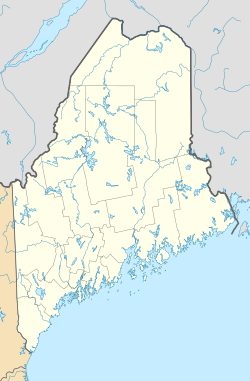The Farm House (Bar Harbor, Maine) facts for kids
Quick facts for kids |
|
|
The Farm House
|
|
| Location | 15 Highbrook Rd., Bar Harbor, Maine |
|---|---|
| Area | 4.2 acres (1.7 ha) |
| Built | 1923 |
| Architect | Arthur McFarland; Beatrix Farrand |
| Architectural style | Colonial Revival |
| NRHP reference No. | 07001152 |
| Added to NRHP | November 7, 2007 |
The Farm House is a special old summer home located at 15 Highbrook Road in Bar Harbor, Maine. It started as a farmhouse in the 1800s. In the 1920s, it was greatly changed by architect Arthur McFarland. He gave it a new look called Colonial Revival style. McFarland also designed a small house for a caretaker on the property.
The estate also has beautiful gardens. These were designed by Beatrix Farrand, a famous landscape architect. All this work was done for Mildred McCormick. She was an heir to the fortune of Cyrus McCormick. He invented the combine harvester, a big farm machine. The Farm House was added to the National Register of Historic Places in 2007. This means it is an important historical place.
Contents
Exploring The Farm House Estate
The Farm House estate covers about 4.2 acres. It is located on the southwest side of Bar Harbor village. The property is divided into different garden areas. Think of them like outdoor "rooms." These rooms are arranged from north to south.
The Garden Rooms
- Eden Street Room: This is the northernmost area. It has a log rail fence and a stone wall. This grassy space has old apple and maple trees. You can also find pine and locust trees here.
- Front Yard: A round gravel driveway is the main feature here. It has pretty flowering bushes and special trees in the middle. There are also some Euonymus bushes. Wooden steps lead to a stone patio in front of the house. These steps are lined with Thuja (arbor vitae) plants. Below the patio are rosa rugosa bushes.
- West Lawn: A lawn on the west side of the house has a stone wall. This wall marks the edge of this garden room. A cedar hedge forms the boundary on the east side of the house.
The Formal Gardens
The back yard is a formal garden space. It was designed by Beatrix Farrand. The house and its west wing form one boundary. A row of Euonymus plants is on the east. A cedar hedge marks the southern edge. Paths made of pea-stone gravel cross each other. One path leads from the house to another Farrand garden room. Four globe arbor vitae trees mark where the paths meet.
The Farrand garden is also a formal space. It is surrounded by a cedar hedge. Most of this area is lawn. At the eastern end, there is a pergola. This is a structure covered with climbing roses and grapes. A large clay pot, called an amphora, sits on the west side. It is placed in a bed of thyme plants. South of this garden is a simple vegetable garden and orchard. It has apple trees, some of them very old.
The Farm House Buildings
The main part of the house is a typical 19th-century Cape house. It has sections called "ells" on each side. A wing extends south from the western ell. The house is covered with clapboards. It sits on a foundation made of cut stone.
Inside, the house was greatly changed in the 1920s. This was done following Arthur McFarland's designs. Some older features from the Federal and Greek Revival styles were kept. McFarland added many Colonial Revival details. These include lots of wood paneling. He also added chair rails, picture rails, and crown molding.
The property also has other buildings:
- Caretaker's Cottage: This was built in 1929. It was also designed by McFarland.
- Garage: A newer, more modern garage is also on the property.
History of The Farm House
The Farm House property was bought in 1916. Robert Hall McCormick purchased it. He then gave it to his daughter, Mildred, in 1922. Mildred McCormick asked Farrand and McFarland to transform the property. It had been a farm. She wanted it to become a beautiful summer estate.
The garden designs by Farrand were highly praised. They received good notice in 1934 from the Garden Club of America. The entire estate shows a trend in Bar Harbor. People wanted summer homes that were easier to take care of. The Farm House is one of the few summer estates that survived. A terrible fire in Bar Harbor in 1947 destroyed many properties.



